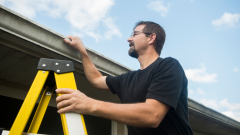Winterize your home
Image

- install storm shutters
- clean the gutters
- check your roof for damage
- ensure proper insulation in the walls and attic
- cover windows with plastic on the inside to keep in heat
- use portable electric space heaters where necessary - remember to keep the area around a space heater clear, and do not leave them running when you leave the house.
Winterize your vehicle
- have a qualified mechanic inspect and prepare vehicle for winter conditions, including:
- snow tires
- general maintenance of the battery
- electronics
- fluids
- thermostat
- lights
- brakes
- Keep an emergency kit in your vehicle with extra clothes, blankets, and candles.
- Ensure that your vehicle's gas tank is always at least half-full.
- Have your 72-hour emergency kit ready in case you need to evacuate or shelter-in-place. Be prepared for power outages.
- Service snow removal equipment and keep a supply of rock salt to melt ice on walkways.
Pet reminder
- Bring pets inside and move livestock to sheltered areas and supply non-frozen drinking water.




